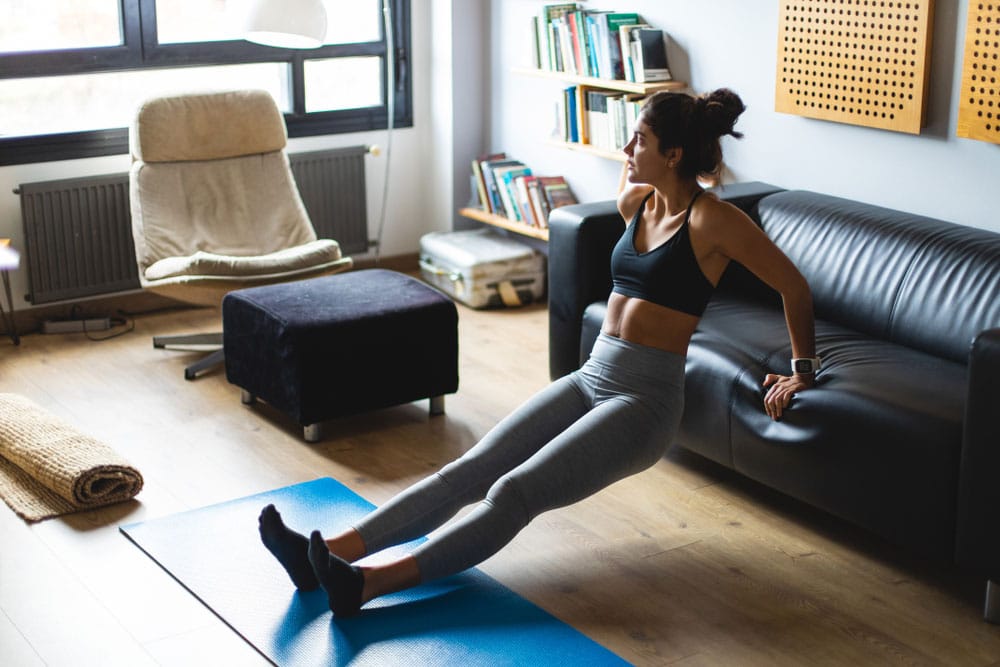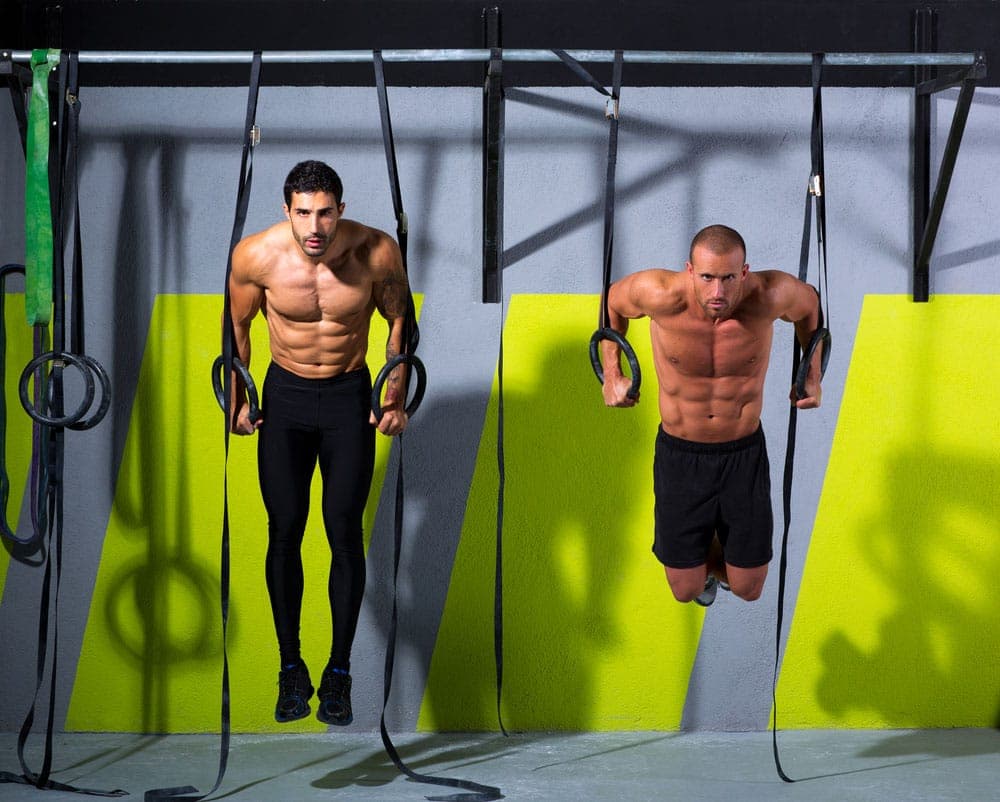Bodyweight Dips: Beginner to Advanced Progressions
This is a guide to how to perform bodyweight dips to improve your tricep strength.
The dip is one of the most fundamental moves to master if you’re looking to get a full-body workout.
Bodyweight dips are a true test of strength. Unlike with weight training, you don’t choose how much you’re lifting. It’s just you vs. your bodyweight here.
That being said, there are some variations and progressions you can work through to make dips easier or harder.
This article will cover the rundown of what muscles dips work, what dip variations you can try from beginner to advanced and what impact bodyweight dips can have on your body.
Bodyweight Dips Muscles Worked
Pectorals
The chest muscles take a major hit when you’re working on your bodyweight dips. During the “down” part of your dip, the pecs help to stabilize you and control your pace of movement. This move puts a lot of strain on your pecs, so make sure to do a chest warm-up before you dip.
If you’re training your chest as part of a push-pull-legs (PPL) split, aim for 2-3 chest exercises per workout. Combining dips with other moves like the bench press (one of the best dumbbell chest exercises) is sure to set your pecs on fire.
Triceps
The triceps are situated on the backs of your upper arms. These muscles activate to resist your bodyweight as you descend into your dips.
Deltoids
The anterior deltoids (front delts) are your front shoulder muscles. When you drop into a dip, anterior deltoids keep your shoulders stable on the way down. Dips recruit a slight amount of lateral delt strength, but don’t impact your rear delts.
Why Should I Do Dips?
Portable
Even if you don’t have a bar set up, dips are one of the easiest take-anywhere exercises you can do.
You can work on dip variations using boxes, benches, the side of your bed, a chair, or even a staircase. If you’re travelling, you can’t just pop a heavy barbell in your luggage for squats and deadlifts.
But dips, on the other hand, are possible pretty much anywhere.

Easy Progression
One of the main benefits of dips is that they’re easier than many exercises to scale up or down. Basically, a bodyweight dip where your heels or feet are planted on the ground is pretty simple to alter in intensity before you lift your legs to use your full weight.
You control how challenging this dip variation by controlling where you place your feet on the ground and how much weight you apply. This makes the move accessible even for total beginners to the gym.
Range of Motion
In a proper dip, your shoulders should move below your elbows. This makes them fantastic for targeting shoulder mobility and range of motion in your upper body.
Many of us have tight or weak shoulders. When you sit at your desk typing all day, you don’t get the adequate amount of motion in your arms that your shoulders require to stay healthy and mobile.
How to Do Bodyweight Dips
- Set-Up: Grab a set of parallel bars or set yourself up at a dip station.
- Grip: Grip the bars comfortably with your hands facing toward each other. The bars should force your grip to be slightly wider than your hips.
- Dip: Extend your arms fully, bringing them to a straight position. This is your starting point. From here, bend both elbows slowly at the same to time to engage your triceps and lower to a dip. When your come to the bottom of your bodyweight dip, your elbows should come to around a 90-degree angle.
- Reverse: Using your strength, drive up, pushing through your triceps to return to the top of your dip and straighten your arms completely. This completes one rep.
- Reps: Continue this move for the desired amount of reps. Aim for 3-4 sets of 5-15 reps.
Dip Progressions and Variations
If you’ve taken an interest in dips, you may be trying them out to see which version of the exercise feels right for your body.
Bent Knee Bench Dips

For this variation, instead of grasping a set of parallel bars, plant the heels of your hands on the edge of a weight bench. You can use a chair, couch, the side of your bed, stairs, or any other comfortable surface.
Plant your feet on the ground with your knees bent at a 90-degree angle about hip-width apart. Brace your legs as you bend your elbows to drop into a dip.
The bent knee variation takes some of the work out of your triceps and shoulders. This makes your bodyweight dips considerably easier than the version with your legs in the air.
Straight Leg Bench Dips
To perform straight leg bench dips, simply repeat the hand setup of bent knee dips, but extend your legs.
A straight leg bench dip variation offers a bit more challenge than the bent-knee version but still offers the support of having your feet on the ground. Try practicing your dips, extending your legs from bent to straight as you get better.
You will see that each point in between feels a little bit more challenging than the last.
Supported Leg Dips
In this variation, you elevate your legs to take some of the challenge out of your dips while mimicking the body position of a full tricep dip.
This helps you build more mind-muscle connection for when you’re ready to bridge into
Negative Dips
Slow negatives are a great way to train for pretty much any challenging move. Simply perform thew “down” portion of your dip in a slow, controlled manner, then drop off your bar at the bottom of the move.
How Many Bodyweight Dips Should I Be Able to Do?
Trained or untrained, everyone’s capacity for dips is different.
10 bodyweight dips is a good rep range for beginners. Advanced athletes may be able to get up to as many as 50 or more reps.
As you progress with bodyweight dips, you can choose to add weight for an additional challenge. Some lifters find, though, that heavy equipment doesn’t let them get the benefit of fully working through their range of motion to really get the advantages in shoulder health.

Because belts or weight plates are, well, incredibly heavy, there’s a temptation not to want to descend all the way into a dip for fear of getting stuck at the bottom.
This is called the “sticking point.” In weight training, actually understanding where and why you’re hitting a sticking point can be one of the most effective ways to improve and fine-tune your training.
You can learn more by reading Understanding and Overcoming the Sticking Point in Resistance Exercise.
If that doesn’t sound fun to you, there are always ways to switch up your equipment to make unweighted dips harder. Let’s get to know them.
What Equipment Can I Use for Dips?
You can add dips to a power tower workout. Most often, this piece of equipment comes with specialized handles for dips.
But one of the best challenges is to perform dips with hanging rings. Ring dips aren’t static like bars, benches or machines. This makes it extra important to focus on your stabilizer muscles. If you want to get a male gymnast body, you need to be doing ring dips.
In competitive gymnastics, or if you want to compete with yourself, this is one of the best moves for a solid upper half.
Are Dips or Push-Ups Harder?
Dips vs. push-ups: which is more challenging?
Unless you have superhuman shoulders, dips are harder. Push-ups provide an extra surface to support you: the floor. This takes a considerable amount of effort out of the move when compared to a tricep dip.
Both, however, tend to pale in comparison to the pull-up. Why are pull-ups so hard? The pull-up is one of the toughest bodyweight workouts because you are required to lift 100% of your bodyweight, while push-ups only require you to lift about 65%.
Although the dip makes you lift about 95-100% of your weight as well, the key difference is that pul-ups work against gravity, while dips work with it. Although you resist your own weight coming down in a dip, it’s more of a struggle to get yourself up to a pull-up bar.
Calisthenics typically mimics people’s natural patterns of movement and there’s no real-world scenario where we’d be doing a pull-up.
The Takeaway
Bodyweight dips are one of the most fundamental movements to master for upper body strength.
To build toned shoulders, triceps and pecs, while avoiding injuries to the shoulder joints, it’s important to work through several progressions to make sure you have the strength to perform them unsupported.
Try working with your knees bent, then straightened, through to a supported leg dip and finally performing slow negatives.
All of these progressions will help you build the muscular strength and mental connections that it takes to be strong in your dips.
References
Kompf, J., & Arandjelović, O. (2016). Understanding and Overcoming the Sticking Point in Resistance Exercise. Sports medicine (Auckland, N.Z.), 46(6), 751–762. https://doi.org/10.1007/s40279-015-0460-2
McKenzie, A., Crowley-McHattan, Z., Meir, R., Whitting, J., & Volschenk, W. (2022). Bench, Bar, and Ring Dips: Do Kinematics and Muscle Activity Differ?. International journal of environmental research and public health, 19(20), 13211. https://doi.org/10.3390/ijerph192013211
McKenzie, A., Crowley-McHattan, Z., Meir, R., Whitting, J., & Volschenk, W. (2022). Fatigue Increases Muscle Activations but Does Not Change Maximal Joint Angles during the Bar Dip. International journal of environmental research and public health, 19(21), 14390. https://doi.org/10.3390/ijerph192114390
Related articles


Get fit with Flex
Build muscle & lose weight fast for free.
Available on iPhone + Apple Watch





